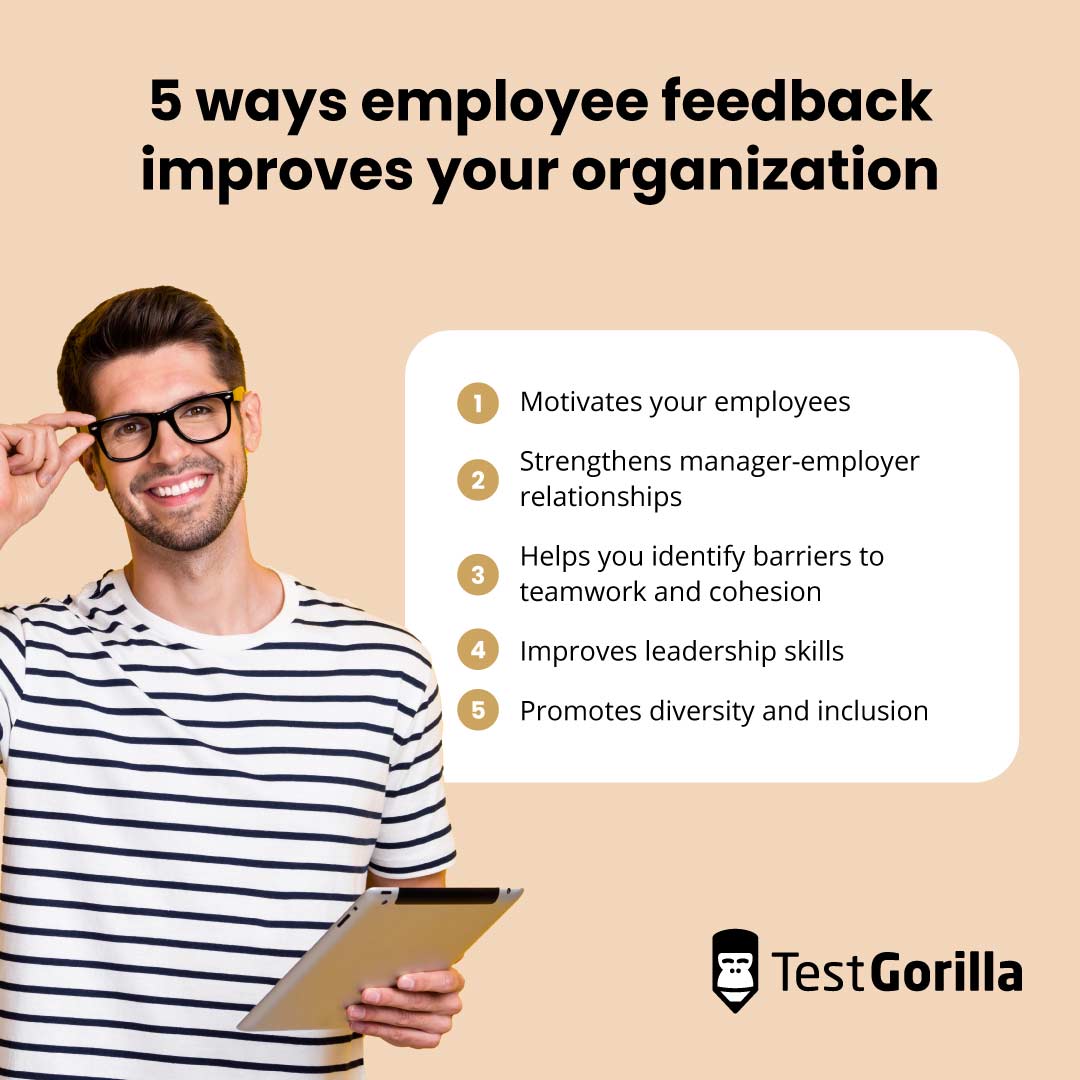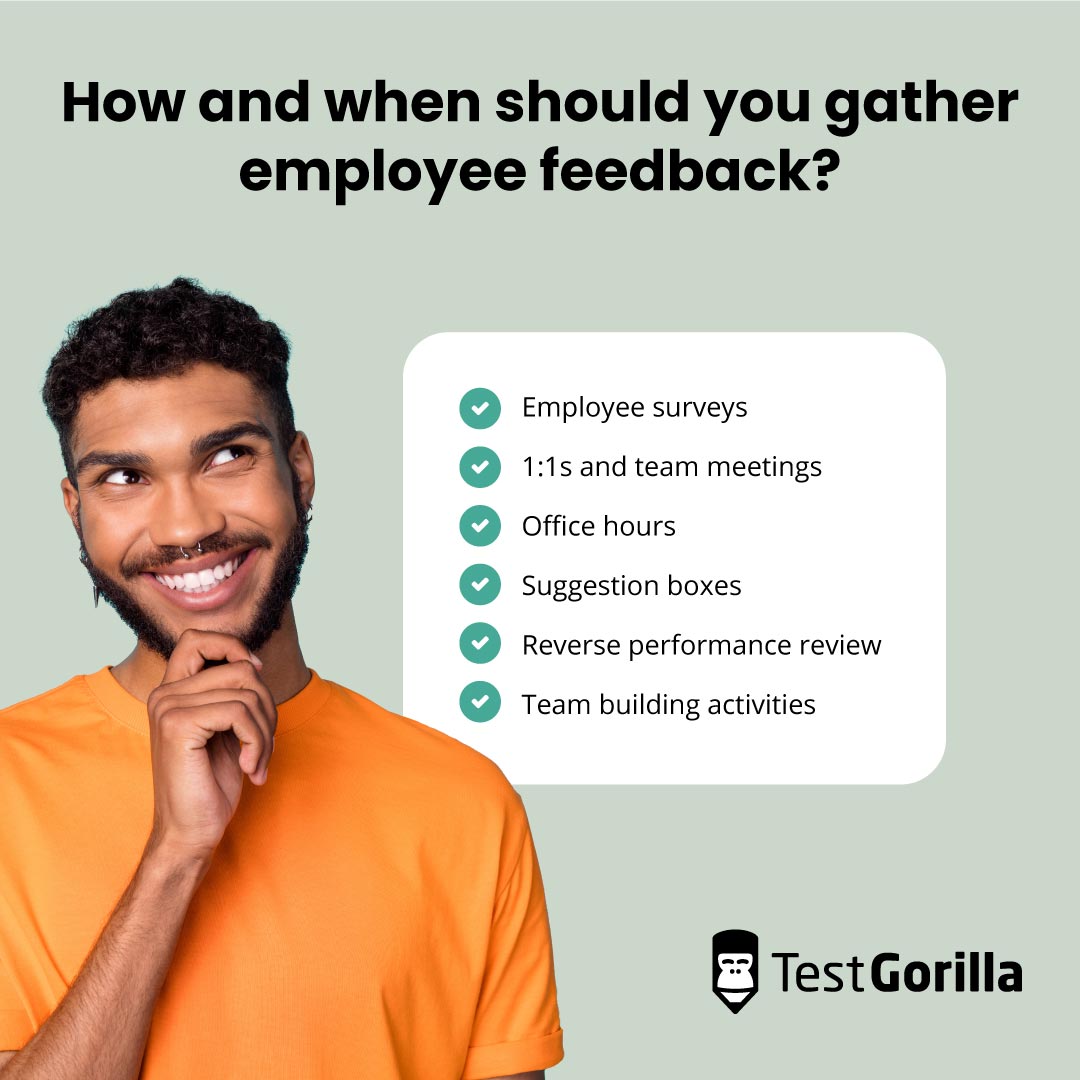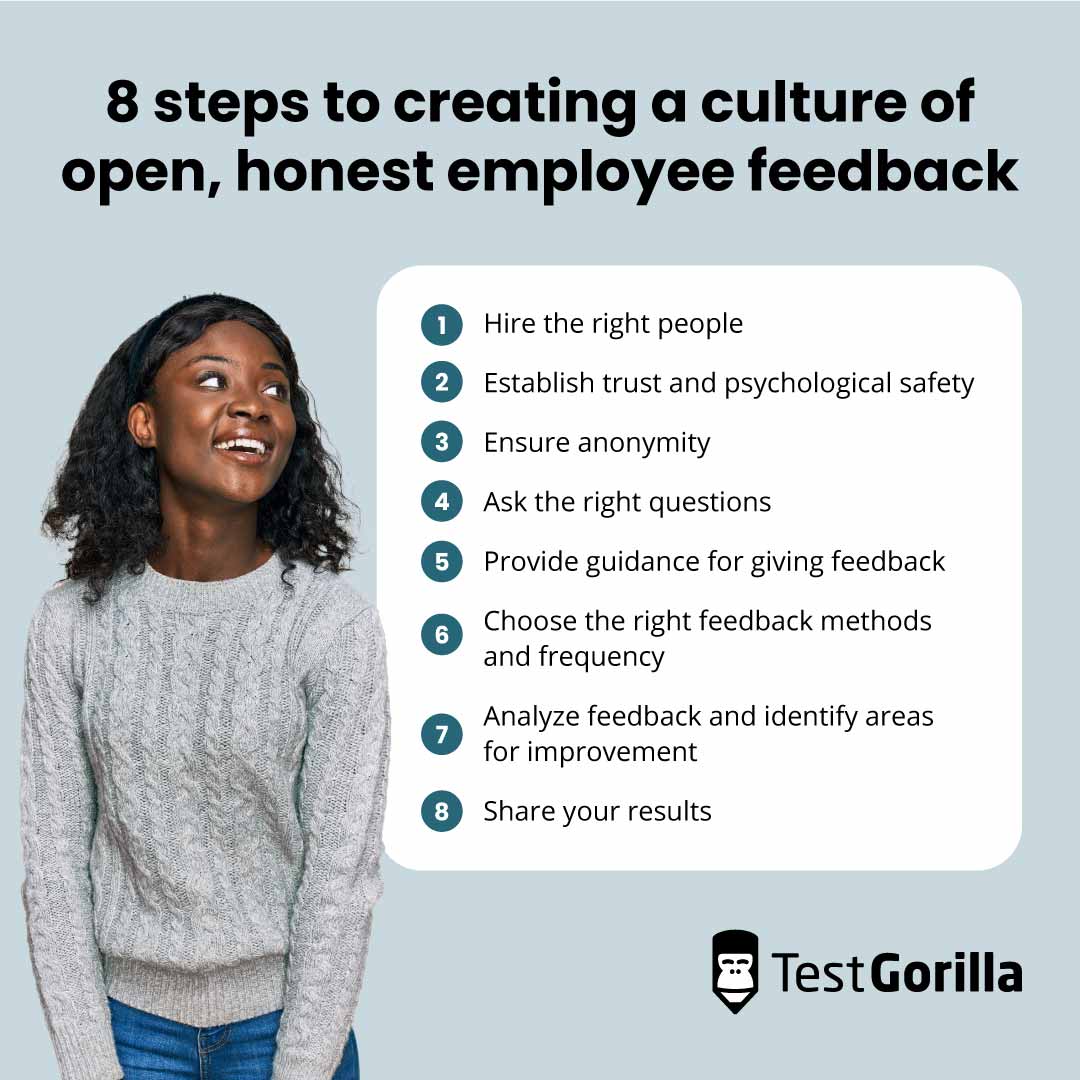How to use employee feedback to create a better workplace
We know giving employees regular feedback is central to good people management – individuals are more likely to feel motivated to do outstanding work when they get frequent constructive feedback from their managers – but what about collecting feedback from your employees?[1]
As much as employees want to hear about how they can improve and progress, they want to feel heard by leadership and management.
When you regularly collect feedback from your people and listen to what they have to say, you’re better equipped to create a workplace they’re excited to be a part of.
In this article, we explore the benefits of collecting employee feedback, suggest the best ways to gather these insights, and share eight strategies for creating an open, honest culture for employee feedback within your organization.
5 ways employee feedback improves your organization
Your employees can’t know what you want from them unless you share feedback with them. Similarly, you can’t know how to improve your organization if you don’t reach out to your people and ask.
Here are five ways employee feedback helps you build a better workplace:
1. Motivates your employees
When you listen to your employees and show them you’re invested in their well-being, it helps you build trust, which is essential to having a motivated team.
Trust in the workplace promotes employee engagement, making people 250% more motivated to work, 41% less prone to absenteeism, and 50% less likely to look for another job.[2]
2. Strengthens manager-employer relationships
Managers also foster a stronger relationship with their team when they ask for feedback from their direct reports.
This practice establishes an open, transparent, two-way relationship where both employee and manager feel comfortable sharing their opinions, praise, and constructive criticism without fear of judgment.
3. Helps you identify barriers to teamwork and cohesion
Perhaps a manager has a different communication style than all of their direct reports. Without feedback from their people, that manager may never realize what’s causing issues and clashes between them and their employees.
Employee feedback helps managers and leadership teams learn about each others’ strengths and weaknesses, helping you work together better.
4. Improves leadership skills
If you want your company to have better leadership, encourage your leaders to talk to your people more. Collecting regular feedback from employees helps them hone skills like active listening, communication, and empathy.
By making an effort to listen to and understand employees' needs, they can become stronger, more compassionate leaders who know how to drive teams while caring for their people.
5. Promotes diversity and inclusion
Getting employee feedback is especially important for understanding what your diverse employees need. When they share their experiences and struggles, you get a better understanding of the types of challenges they’re facing so you can act to address the issues.
Whether that’s counteracting implicit bias or drawing attention to unfair policies, talking to your people will help you build better DE&I initiatives.
How and when should you gather employee feedback?
Quarterly surveys aren’t the only way to get feedback from your employees. Here are some trusted methods for collecting insights from your people:
Employee surveys. Send out regular surveys to take the pulse on how your people feel about your organization in general, as well as certain aspects of their job. We recommend making them anonymous to encourage people to answer honestly without any fear of judgment or reprisal.
1:1s and team meetings. Make feedback a regular part of employees’ meetings with their managers and departments. Give employees a designated space, for example, an Excel sheet, to leave feedback that can be discussed during 1:1s, and carve out 10 minutes of team meetings for open, ongoing feedback about what happened in the week prior.
Office hours. Holding regular office hours is another way to encourage employees to share their honest opinions. These meetings are often more laid back than 1:1s, helping people feel more comfortable about sharing their thoughts (and giving them a designated space to do so).
Suggestion boxes. You want to make sure your people have a place to leave feedback even when they aren’t prompted, so set up a virtual suggestion box. You can do this using whatever HR software you use, or, for in-person companies, set up an actual suggestion box in your break room. Again, keep it anonymous to help people be as transparent as possible.
Reverse performance review. Reverse performance reviews, or when employees review their managers, are the perfect opportunity for them to share feedback. Keep these anonymous as well to encourage your people to be honest and candid, and ask them specific questions to prompt their feedback and give them ideas on what to share.
Team building activities. In team building activities like retreats and offsites, employees are often more relaxed and at ease, helping them feel more comfortable about sharing their honest opinions. Be sure to organize a session for discussing and sharing feedback during these events, as employees’ thoughts and opinions can flow more organically.
The best insights on HR and recruitment, delivered to your inbox.
Biweekly updates. No spam. Unsubscribe any time.
8 steps to creating a culture of open, honest employee feedback
Getting valuable feedback from your employees won’t happen overnight.
Here are eight steps you can take to help gather actionable insights, opinions, and suggestions from your people so you can build a better workplace.
1. Hire the right people
Building a culture of employee feedback starts with having leaders that people can trust. This is why it’s essential to hire managers with soft skills that let them receive and act on feedback without feeling attacked or becoming defensive.
When hiring for leadership positions, use talent assessments to measure skills related to communication, active listening, and a candidate’s ability to obtain actionable insights from feedback. With your existing people, focus on developing great leaders by assessing where they’re at with these skills and giving them the training and resources they need to further develop them.
2. Establish trust and psychological safety
Individuals won’t feel comfortable sharing their honest opinions unless they feel safe at work, which is why you need to create a psychologically safe workplace. This means fostering an environment where everyone feels they can express their ideas and concerns without fear of negative consequences.
Build trust between leadership and employees by showing that when an employee makes a complaint, it’s met with compassion and consideration, and is never shot down. Also, you can create employee resource groups (ERGs) to give your people a safe space to discuss their ideas and concerns, helping them feel like they have allies before they take their feedback to leadership.
3. Ensure anonymity
It should come as no surprise that some employees don’t want their identity disclosed when they offer feedback. Never make it mandatory for people to give their name when sharing their opinions, and create a permanent space for completely anonymous feedback if employees don’t feel comfortable directly sharing their thoughts with their manager.
It’s a pretty straightforward concept, but ensuring anonymity isn’t always as simple as it seems, so take extra precautions to ensure any surveys you use can be completely anonymous. For example, that may mean asking employees not to disclose their demographic information, as certain characteristics might single out members of your team.
4. Ask the right questions
Leaving a blank, open-ended field on your feedback forms won’t do you any favors. If you want to get truly helpful, valuable, and actionable insights from your people, you need to ask the right questions.
They should be clear, specific, and relevant to your goals. For example, if you’re aiming to make your organization more inclusive, ask questions like, “Do you think our company celebrates diverse ideas and people?” or “On a scale of 1 to 10, how well do you feel you can talk about your background without being judged?”
5. Provide guidance for giving feedback
If you’re not getting the type of feedback you’d like from your employees, it’s probably not because they don’t have anything to say. Giving feedback is a skill in itself, so they may need some support and guidance on developing this ability.
We suggest teaching specific frameworks that make it easier to clearly communicate feelings, issues, and hopes. Some examples include the SBI model (Situation Behavior Impact), the SAID model (Strengths Action Impact Development), the Stanford method, and the McKinsey Feedback Model.
6. Choose the right feedback methods and frequency
To figure out which method and frequency is right for your team members, send out a survey. Some employees may prefer sharing feedback directly with their managers during reverse performance reviews, while others may appreciate a quarterly anonymous survey.
You don’t want to bombard your employees by soliciting feedback from them every week, but twice a year probably isn’t enough. Aim to find a middle ground, whether that’s once a month or once a quarter, to reach out to your employees for their feedback (and make it clear that they’re always welcome to leave unsolicited feedback via your anonymous channel).
7. Analyze feedback and identify areas for improvement
Collecting feedback is just the start. If you want to make the most of the insights your employees share, you need to know how to correctly analyze them. Start by looking for patterns, which will help you identify if there are any trends you should look out for. For example, does one department in particular have issues with how their manager communicates?
Identifying these areas of improvement will help you design an action plan on how to improve. In the above example, this may mean using talent assessments to measure the communication skills of the manager in question and giving them the resources they need to improve.
You can also incorporate your learnings, when relevant, into your organization’s DE&I strategies to help give them the best chance of success.
8. Share your results
Have you ever filled out a survey to then hear no follow-up about it down the line? It can be discouraging for employees to take the time to share their opinions only to feel they’ve been disregarded.
Share the results of your employee feedback collection and analysis with your team, and make sure to let your people know how you’re going to act in response.
Whether it’s implementing a communication training program for your managers or modifying your DE&I policies, explaining how you’re going to use feedback to improve your shared workplace is rewarding for employees and will motivate them to share more opinions going forward.
The key to building a better workplace? It’s in employee feedback
You ask your customers for feedback and talk to users to figure out how to improve your offering. So why aren’t you asking your employees how you can build a better workplace?
If you want to create an organization people are excited to be a part of, you need to have open feedback baked into your company culture. This all starts with the people you hire.
Use talent assessments during your recruitment process to take a skills-based approach to hiring, rather than relying on traditional methods like resumes and referrals. This way, you can test for relevant soft skills, like communication and active listening, to ensure your leaders are well-equipped to receive and act on feedback.
Plus, skills-based hiring helps you build a more diverse organization, with 91% of companies that implement the practice reporting an increase in workplace diversity. This helps you foster an inclusive culture where your employees will feel comfortable speaking up and sharing the valuable feedback you need to create the best possible workplace.
Want to be sure you’re hiring the right leaders for collecting feedback? TestGorilla’s talent assessments help you measure candidates’ soft skills, ensuring you’re picking the right person for the job. Check out our test library |
Sources
“How Fast Feedback Fuels Performance.” (2022). Gallup. Retrieved September 4, 2023. https://www.gallup.com/workplace/357764/fast-feedback-fuels-performance.aspx
“How to Build a High-Trust Workplace.” (2023). MIT Sloan Management Review. Retrieved September 4, 2023. https://sloanreview.mit.edu/article/how-to-build-a-high-trust-workplace/#:~:text=Our%20research%20shows%20that%20trust,don't%20trust%20their%20employer.
Related posts
You've scrolled this far
Why not try TestGorilla for free, and see what happens when you put skills first.

















